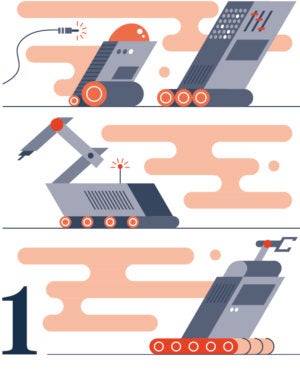 1 More flexibility with wireless factories
1 More flexibility with wireless factories
Network-connected machines can do more than so-called dumb ones. However, manufacturers typically use ethernet and wifi, and progressively 4G LTE, to connect factory devices.
But with 5G, operators can power their entire facility, on and off-premises, seamlessly with one network for near-wireless operations and quicker adoption of new technologies.
“A robot can come with an inbuilt SIM that is easily connected to the 5G network, so operators can plug and play, as opposed to establishing a new network for it, which creates barriers to adoption,” says Guido Jouret, chief digital officer at ABB. “A factory with good wireless connectivity can produce more because robots can work 24/7.”
Wireless machines can also roam more freely, increasing flexibility and productivity. And with the low latency provided by 5G, around 10 milliseconds and eventually 1 millisecond compared with 20 to 30 milliseconds with 4G, they can be monitored in real time by the human in the loop.
Furthermore, adoption of 5G for manufacturing will move function normally located inside the robot to a central computer via distributed cloud or edge computing.
“This reduces cabling costs and increases flexibility as machinery can be reprogrammed and moved around easier; manufacturing needs to be adaptable to cater for increasing demand for more personalised products,” says Mats Norin, programme manager at 5G For Industries, Ericsson Research.
 2 Increased productivity
2 Increased productivity
For manufacturers, productivity gains equal cost-savings. The 5G network allows for up to one million sensors per square kilometre, as well as ultra-low latency, which can provide operators with real or near-time data from sensor-equipped devices to improve productivity.
Using 5G-enabled technologies for increased data capture, MTU Aero Engines, a company that produces bladed disks for engines, working with Ericsson and Germany’s Fraunhofer Institute for Production Technology, managed to reduce its process design phase by 75 per cent.
Additionally, the real-time monitoring provided by 5G’s low latency enables the company to improve monitoring of the manufacturing process to avoid errors; within milliseconds operators know when they need to change machine parameters or risk having to reconfigure the part. According to Ericsson, this case study alone could create annual savings of approximately €27 million for a single factory.
In fact, the more complicated the factory process, the more of it can be automated for bigger savings.
“The more parts that need to be transported, the more production steps and vendors, the more distributed the set-up is, the higher the benefits from 5G industrial digitisation,” says Bela Virag, managing partner at technology management consultancy Arthur D. Little.
 3 Real-time predictive maintenance
3 Real-time predictive maintenance
Maintenance is a major cost for manufacturers, as broken machines halt production costing anything from thousands to millions of pounds. 5G-powered predictive maintenance, however, can help prevent failures before they happen.
Experts at the Worcestershire 5G Consortium, a UK hub to test use-cases of 5G, working with Worcester Bosch, managed to increase factory productivity by around 1 per cent by adding thousands of sensors to machines for health monitoring, which enabled them to prevent breakdowns.
Over a year, just for the manufacturing sector, this translates into a £2-billion contribution for UK GDP, says Mark Stansfeld, chair of Worcestershire Local Enterprise Partnership and 5G lead for Midlands Engine.
Predicative maintenance is possible now, but the ultra-low latency provided by 5G increases the risk of catching breakdowns before they occur.
“Latency is truly important here because with an overheating machine, a mere few seconds later, hundreds of thousands of pounds-worth of damage could be done,” says Mr Stansfeld.
 4 Tailored connectivity
4 Tailored connectivity
Managing connectivity is, of course, another outlay and inevitably increases security considerations, especially for critical operations. However, the ability to slice the 5G network into multiple virtual networks, so speed, capacity, coverage and encryption can be tailored to the specific needs of different machines and operations, can improve security and keep costs down.
“Slicing offers manufacturers a dedicated system which they can fully control to support their internet of things (IoT) solutions,” says Dritan Kaleshi, head of technology for 5G at UK innovation centre Digital Catapult. “It provides reliable communications with guaranteed quality of service, along with cloud-based computation that is under the operator’s absolute control.”
Though dedicated networks already exist, the 5G network is more easily segmented, so factories could even provision additional network slices, as and when needed, to support changes in the volume of production.
“This means manufacturers are only paying for what they need, creating longer-term savings,” explains Jason Elliott of 5G Market Development at Nokia.
Using multi-access edge computing with 5G, Nokia has demonstrated that data can be processed closer to the factory assembly line where it’s needed, reducing latency further.
A study conducted by Ericsson and BT found that compared with conventional networks, network slicing is the best and most economic model for IoT service delivery and can provide a 150 per cent economic benefit.
 5 New business models
5 New business models
As purchasing of goods changes, new manufacturing business models will arise that firms need to be ready to exploit. Through its research, the Worcestershire 5G Consortium has identified a new opportunity for machine manufacturers to sell time on machines through dedicated networks via a platform model commonly used in the consumer sector.
“In the past, these manufacturers would have sold several machines a year, but due to the increased flexibility enabled by 5G, they can instead sell machines on subscriptions,” says Mr Stansfeld of Worcestershire Local Enterprise Partnership and 5G lead for Midlands Engine. “This reduces capital expenditure for the purchaser as buying a machine can be upwards of £500,000, while also providing more flexibility.” The consortium is in the process of testing the model.
This is particularly pertinent for manufacturers producing materials for the automotive sector, he says, whereby smaller providers are tasked with experimenting and developing new products.
Furthermore, Mr Jouret at ABB says increased flexibility will enable manufactures to say yes to more work they would otherwise have to turn down.
“Any factory is in some sense inflexible because it’s optimised to produce certain things; however, if it’s possible to easily reprogram equipment, manufacturers can produce items in smaller batches, for example in less than 10,000 units, which they typically find hard to do today,” he explains.
